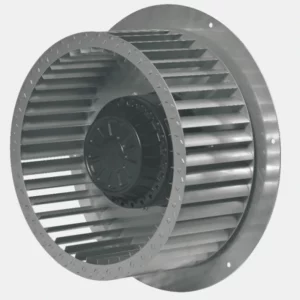A forward-curved centrifugal fan is a type of centrifugal fan that features blades curved in the direction of the fan’s rotation. The blades curve forward, resembling a shallow S-shape when viewed from the side. This design gives the fan its name.
Here are some key characteristics and features of forward-curved centrifugal fans:
- Blade Design: The blades of a forward-curved centrifugal fan are typically curved in a convex shape, with the leading edge positioned in the direction of rotation. The curvature of the blades allows for efficient airflow generation.
- Airflow and Pressure: Forward-curved centrifugal fans are known for generating high airflow volumes at relatively low pressures. They are suitable for applications that require moving a large volume of air with lower resistance or static pressure, such as in HVAC systems or general ventilation.
- Efficiency: These fans are generally efficient in converting input power into airflow. The curved blade design helps to minimize turbulence and improve the overall efficiency of the fan.
- Noise Levels: Forward-curved centrifugal fans tend to operate at lower noise levels compared to other centrifugal fan types. The curved blades and streamlined design contribute to reduced noise generation during operation.
- Size and Compactness: Forward-curved centrifugal fans are often compact in size, making them suitable for applications where space is limited. Their compact design allows for easy integration into HVAC systems, air handling units, or other equipment.
- Applications: Forward-curved centrifugal fans find applications in various industries and systems, including HVAC systems for commercial and residential buildings, air handling units, air conditioning units, air purification systems, and cleanrooms. They are commonly used in situations where high airflow and lower pressure requirements are necessary.
It’s important to note that forward-curved centrifugal fans are sensitive to changes in system resistance forward curved centrifugal fan and should be properly sized and matched to the specific application requirements. Consulting with experts or suppliers can help determine the most suitable fan type for a particular application.
How does a forward-curved centrifugal fan compare to a backward-curved centrifugal fan in terms of performance?
When comparing forward-curved centrifugal fans to backward-curved centrifugal fans in terms of performance, there are several key differences to consider:
- Airflow and Pressure: Backward-curved centrifugal fans typically generate higher static pressure compared to forward-curved fans. This makes backward-curved fans more suitable for applications that require higher pressure, such as in HVAC systems with longer duct runs or systems that need to overcome higher resistance.
- Efficiency: Backward-curved centrifugal fans are generally more efficient than forward-curved fans. The backward-curved blade design allows for better aerodynamics, reduced turbulence, and improved efficiency in converting input power into airflow. This higher efficiency can result in energy savings and lower operating costs over time.
- Noise Levels: Forward-curved centrifugal fans tend to operate at lower noise levels compared to backward-curved fans. The curved blade design and streamlined shape of forward-curved fans contribute to reduced noise generation during operation. This makes them suitable for applications where noise reduction is important, such as in residential or quiet environments.
- Size and Compactness: Forward-curved centrifugal fans are often more compact in size compared to backward-curved fans. The compact design of forward-curved fans allows for easier integration into space-constrained applications or equipment.
- System Resistance: Backward-curved centrifugal fans are better suited for higher system resistance due to their ability to generate higher static pressure. They can handle situations where there are longer duct runs, filters, or other components that create resistance to airflow.
- Operating Range: Forward-curved centrifugal fans are typically selected for low to medium pressure applications, while backward-curved fans excel in medium to high-pressure applications. The choice between the two depends on the specific requirements of the application and the system’s pressure demands.
It’s important to note that the selection of the fan type should consider the specific application requirements, including the desired airflow, pressure, noise levels, and system resistance. Consulting with experts or suppliers can help determine the most appropriate fan type for a particular application.
